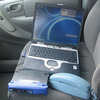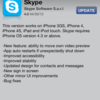For instance, Sprint's PPC-6700 Windows Mobile 5.0 device allows WiFi and EVDO (data transmission) to be active simultaneously, however if your phone rings (voice transmission), you drop the data transmission. It's one or the other. Some of it is a technology issue. That is, the chipsets used by the cellphones share the same antenna and can only transmit using one of the wireless standards. Other times, it has nothing to do with the technology - the service provider simply decides to block simultaneous voice & data transmission for the sole purpose of protecting their turf. Perfect example - Rich Tehrani's Verizon XV6700 Windows Mobile 5.0 phone (Verizon's exact same model as the Sprint PPC-6700) is restricted to only one network at a time. If you turn on WiFi you can't even receive cellular calls. This forces users to stay in "voice" mode the majority of the time, otherwise you can't receive any phone calls.
One of the promising solutions to the problem is UMA or Unlicensed Mobile Access. UMA, will help those who have Wi-Fi routers overcome any poor coverage in their homes while simultaneously leveraging inexpensive VoIP/Internet calls instead of the more expensive cellular network calls. UMA works by tunneling cellular packets through the Internet when a WiFi connection is available and then reverting back to cellular towers when there is no WiFi. A back-end controller inside the network makes the switch on-the-fly.
As I mentioned, voice minutes over a Wi-Fi network is much less expensive than minutes on cellular networks because they leverage Wi-Fi's free unlicensed radio spectrum and the Internet and do not require a footprint of large cell towers. Indeed, UMA along with IMS (IP Multimedia System) are two technologies that promise to be huge in the next 6 months to a year. Side note: One of TMC's newest publications, IMS Magazine, tracks the IMS market - definitely worth checking out.
On a related note, Motorola is also looking to provide the ability to run data and voice simultaneouly. Motorola has a partner called Homeland Integrated Security Systems that uses the Motorola iO200 iDEN modem to provide multiplexing of voice, data, and even GPS location on an iDEN network. They claim to be the first wireless GPS/Data/voice device with the ability to run data and voice at the same time.
Check out the release:
HOMELAND INTEGRATED SECURITY SYSTEMS' CYBER TRACKER FIRST GPS DEVICE TO RUN DATA AND VOICE SIMULTANEOUSLY Revolutionary Wireless GPS/Data Device First Location Based Device to Offer Multiplexing Ability
Homeland Integrated Security Systems (OTC:HISC) has recorded another "first" with its revolutionary Cyber Tracker. The wireless GPS/Data device is the first location based device with the ability to run data and voice at the same time. Traditional devices running data applications are not able to provide voice conversations simultaneously.
Using the Motorola iO200 iDEN® modem, the Cyber Tracker is the first GPS device to provide multiplexing on an iDEN network. The Motorola iO200 is an embedded module providing circuit/packet data connectivity, interconnect and dispatch calls. At only 2" x 2" square, the Motorola iO200 is smaller than other iDEN data devices, which require mounting with an external power source. Modems to date have not allowed voice conversations to be placed while running a data application. Traditionally when someone is trying to reach an individual running a data application they receive a message "user busy in data". With the Cyber Tracker, the data transmission will be put on hold to allow the voice conversation to take place. Once the conversation has ended, the unit will send the stored data and resume normal operation.
"The ability of the Cyber Tracker to provide voice and data at the same time makes it invaluable to a variety of applications," said Frank Moody, CEO of Homeland Integrated Security Systems. "This means someone using the Cyber Tracker as a wireless modem will still have the ability to have voice contact with the home office or dispatcher. Law enforcement, delivery services, emergency services and others will find this capability extremely important."
The Cyber Tracker is currently the only portable, low cost device that supports Push to Talk, tracking and computer functions without utilizing a cellular phone. The Cyber Tracker incorporates a single board design with the Motorola iO200 modem, the Intel X scale processor, and extended battery life along with exclusive Cyber Tracker technology. This allows the unit to work as a portable processing device, creating a product with no boundaries or wires at a reasonable cost. The Cyber Tracker's convenient rugged design (5" x 5" x 1") makes it applicable in a variety of situations where it is necessary to know the exact location of a person, vehicle or other object.













